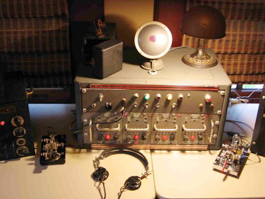home | north bay bohemian index | news | north bay | news article

Photograph by Richard Dillman
PERIOD PIECE: The old equipment at Marconi works again.
Back for Morse
Turning back the clock at West Marin's wireless radio outpost
By Bruce Robinson
The historic Marconi wireless receiving station overlooking Tomales Bay at Marshall had been shuttered for two years before Richard Dillman mustered the will to revisit it.
Fascinated by the old radio operation since boyhood, he listened regularly at home and stopped by from time to time as he grew older. So he took it hard when the facility closed in 1997.
"But when I did go back, what I found was that the station was virtually intact," he marvels now. "It was like a time capsule. It looked like they had walked away 20 minutes ago. And in fact, the receivers were still on, maintaining sort of a symbolic watch over the airwaves, so you could hear the ships calling, you could hear the Morse code. And I just thought, well, we have to do something about this."
With a colleague, Dillman founded the Maritime Radio Historical Society and appealed to the Point Reyes National Seashore's administration to preserve and restore the station. "We said, 'This is valuable, this is historic, it needs to be preserved. And not only that, we're the guys who can do it.' And amazingly enough," he laughs quietly, "they agreed to that."
Nine years later, both the receiving station at Marshall and its counterpart transmission site at Bolinas are back in working order, although the latter no longer occupies its original 1913 home atop the headlands. "The cliff is getting closer and closer" to the now-vacant building, Dillman concedes, "and eventually it'll go over the side."
But the venerable Marshall station stands above the water and east of Highway 1, now part of the Marconi Conference Center, itself part of a California State Historic Park. And this Friday and Saturday, it will bustle again during the Radio Days open house for students and the general public, at which Dillman and others will show off and demonstrate the early broadcast technology of the past century.
"The idea is to replicate the whole thing as closely as we can," he explains. "We use period gear as much as we can and put the station back on the air. We'll be handling message traffic, telegram traffic, just as they did. For the people who will be attending, we'll be sending that in Morse code to real addressees, who will actually get the message, just like they did in the Western Union days."
This modern recreation was actually enabled by the staff of the station decades ago. "You'll see transmitters going back to the 1940s, because when they took them out of service, they didn't junk them, they just left them there," Dillman says. Now restored, "they are transmitters that are unique in the world," he explains. "There's no place else you can go to see these things, and especially not see them in full operation."
In its heyday, before and after World War I, the Marconi dual station in West Marin was part of a network of point-to-point and ship-to-shore communications that reached around the globe, an operation that continued until the attack on Pearl Harbor on Dec. 7, 1941. In recent years, Dillman and his partners have revived the service—the licenses remain current—regularly on weekends, to a surprisingly fervent response.
"People around the world hear these transmissions," the radio buff says. "We get letters and emails from folks who stand by for us, sometimes in the early morning hours in their part of the world, just waiting with the earphones on to hear these signals once again. Many of them were shipboard radio operators, and they write very emotional letters, saying, 'I sailed for 30 years on all the oceans of the world. I never thought I'd hear that station again, but last night those signals were coming up out of the static.' So it really means a lot to these people."
It's much more a calling than a hobby for Dillman, too. He points out that the Marshall station operates in the historic "medium frequency" band on the broadcast spectrum.
"This is the frequency that was established after the Titanic disaster, as a international distress frequency," Dillman says. "This is where all the SOS's were sent, where some of them sent their very last words. We consider it sacred ground. Even though there is no ground, it's just a frequency in the air, it's a very hallowed spot on the radio dial."
The Marconi Center's Radio Days are slated for Friday–Saturday, Nov. 21–22. Friday is for area schools; Saturday, the exhibit is open to the public from 10am to 3pm. Marconi Conference Center, 18500 State Hwy. 1, Marshall. Free. 415.663.8151.
Send a letter to the editor about this story.
|
|
|
|
|
|